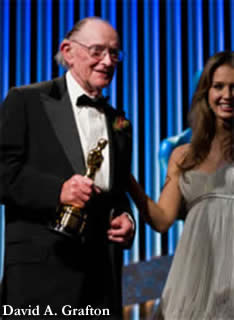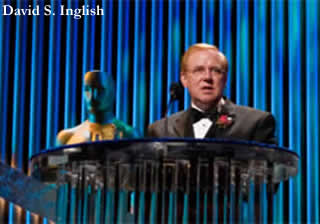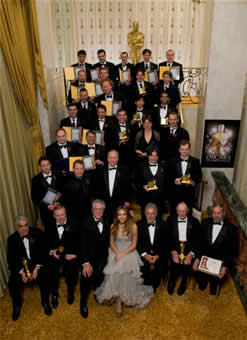 It is a little heralded fact that the first Oscar statuettes of the season are awarded before the Oscar telecast watched the world over. The men and women who make the incredible cinematic, digital and audio tools that make film possible, down to the emulsion itself, are feted at a black tie ceremony at The Beverly Wilshire (the starring hotel in the film “Pretty Woman”) before the Oscar extravaganza Feb. 24. A number of certificates, plaques and the statuettes are awarded by the Scientific and Technical Awards Committee of The Academy of Motion Picture Arts and Sciences.
It is a little heralded fact that the first Oscar statuettes of the season are awarded before the Oscar telecast watched the world over. The men and women who make the incredible cinematic, digital and audio tools that make film possible, down to the emulsion itself, are feted at a black tie ceremony at The Beverly Wilshire (the starring hotel in the film “Pretty Woman”) before the Oscar extravaganza Feb. 24. A number of certificates, plaques and the statuettes are awarded by the Scientific and Technical Awards Committee of The Academy of Motion Picture Arts and Sciences.
Oscar statuettes were awarded to David A. Grafton, with the Gordon E. Sawyer Award, and the Eastman Kodak Co., with the Academy Award of Merit, for the development of photographic emulsion technologies incorporated into the Kodak Vision2 family of color negative films.
Grafton is a pioneering designer of lenses for optical effects printers, which at the time of their development were adopted by nearly every visual effects facility in the motion picture industry and enabled the seamless blending of multiple images from different sources. He worked for many special effects companies, such as Industrial Light & Magic and Boss Film Studios; and contributed to the production of numerous feature films, including “Star Wars,” “The Empire Strikes Back” and “Blade Runner.”
adopted by nearly every visual effects facility in the motion picture industry and enabled the seamless blending of multiple images from different sources. He worked for many special effects companies, such as Industrial Light & Magic and Boss Film Studios; and contributed to the production of numerous feature films, including “Star Wars,” “The Empire Strikes Back” and “Blade Runner.”
Established in 1981, the Sawyer Award is “presented to an individual in the motion picture industry whose technological contributions have brought credit to the industry.” Grafton, the 21st recipient of the award, received a standing ovation from his assembled peers.
Kodak picked up its 20th sci-tech award, for technologies that are breakthroughs in film speed, grain and sharpness that have made a significant impact on the motion picture industry. The Vision 2 family allows wider use of high-speed color negative film, lower light levels on set and faster set-ups. Most importantly, Vision2 improves the overall picture quality in theatrical presentation.
The ceremony is hosted by just one celebrity each year, a daunting task for the actress who must read the trying technological copy. Handling the duties this year was a prettily pregnant Jessica Alba (“The Eye,” “Fantastic Four” and “Dark Angel”) who stumbled verbally only once near the end of the ceremony.
 Most of the awards were given to computer-programmers and technical artists who developed fluid effects.
Most of the awards were given to computer-programmers and technical artists who developed fluid effects.
Scientific and Engineering Awards (Academy Plaque) went to Dr. Doug Roble, Nafees Bin Zafar and Ryo Sakaguchi for the development of the fluid simulation system at Digital Domain. This influential and flexible production-proven system incorporates innovative algorithms and refined adaptations of published methods to achieve large-scale water effects.
Also garnering plaques for fluid effects were Nick Rasmussen, Ron Fedkiw and Frank Losasso Petterson for the development of the Industrial Light & Magic (ILM) fluid simulation system. This production-proven simulation system achieves large-scale water effects within ILM’s Zeno framework. It includes integrating particle level sets, parallel computation, and tools that enable the artistic direction of the results.
A Technical Achievement Awards (Academy Certificate) went to Victor Gonzalez, Ignacio Vargas and Angel Tena for the creation of the RealFlow software application.
application.
RealFlow was the first widely adopted, commercially available, easy-to-use system for the simulation of realistic liquids in motion picture visual effects.
Another certificate for fluid effects went to Jonathan Cohen, Dr. Jerry Tessendorf, Dr. Jeroen Molemaker and Michael Kowalski for the development of the system of fluid dynamics tools at Rhythm & Hues. This system allows artists to create realistic animation of liquids and gases, using novel simulation techniques for accuracy and speed, as well as a unique scri pting language for working with volumetric data.
Additional fluid winners of the certificate were Duncan Brinsmead, Jos Stam, Julia Pakalns and Martin Werner for the design and implementation of the Maya Fluid Effects system. This system is used to create simulations of gaseous phenomena integrated into the widely available Maya tool suite, using an unconditionally stable semi-Lagrangian solver.
Certificates for fluid effects achievements also flowed to Stephan Trojansky, Thomas Ganshorn and Oliver Pilarski for the development of the Flowline fluid effects system.
Flowline is a flexible system that incorporates highly parallel computation, allowing rapid iteration and resulting in detailed, realistic fluid effects.
Receiving a certificate, not for fluids, was Christien Tinsley for the creation of the transfer techniques for creating and applying 2D and 3D makeup known as “Tinsley Transfers.” These techniques allow quick and precisely repeatable application of 2D makeup such as tattoos, bruises and birthmarks, as well as 3D prosthetic appliances ranging in size from small wounds to entire torsos. They utilize self-adhesive material that features an unprecedented combination of tissue-thin edges, resilience, flexibility and water resistance, while requiring no dangerous solvents.
Certificates also went to Jörg Pöhler and Rüdiger Kleinke of OTTEC Technology GmbH for the design and development of the battery-operated series of fog machines known as “Tiny Foggers.” The operating characteristics of this compact, well-engineered and remote-controllable package make possible a range of safe special effects that would be totally impractical with larger, more conventional fog units.
 Also awarded certificates were Sebastian Cramer, for the invention and general design and Andreas Dasser, head of development at P&S; Technik GmbH, for the mechanical design of the Skater Dolly and its family of products. This small, portable, camera-only dolly allows low lens positions, movement in restricted places and tight offset circular maneuvers with rapid set-up.
Also awarded certificates were Sebastian Cramer, for the invention and general design and Andreas Dasser, head of development at P&S; Technik GmbH, for the mechanical design of the Skater Dolly and its family of products. This small, portable, camera-only dolly allows low lens positions, movement in restricted places and tight offset circular maneuvers with rapid set-up.
Jonathan Erland received the Award of Commendation (Special Plaque) in recognition of his leadership and efforts toward identifying and solving the problem of High-Speed Emulsion Stress Syndrome in motion picture film stock. By coordinating and conducting tests for and with the industry and by sharing results openly, he demonstrated the value and effectiveness of independent research and industry-wide cooperation.
Also receiving a standing ovation was David S. Inglish, who received the John A. Bonner Medal of Commendation (Medallion) for his outstanding service and dedication in upholding the high standards of the Academy of Motion Picture Arts and Sciences. English, director of audio and video technology for Universal Pictures helped Disney covert to the CAPS system
Unlike other Academy Awards, achievements receiving Scientific and Technical Awards need not have been developed and introduced during 2007. Rather, the achievements must demonstrate a proven record of contributing significant value to the process of making motion pictures.

